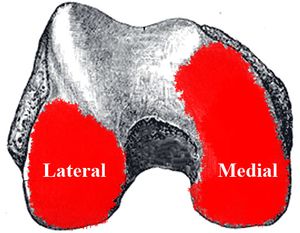Screw Home Mechanism of The Knee Joint
Definition[edit | edit source]
Screw home mechanism (SHM) of knee joint is a critical mechanism that play an important role in terminal extension (last 15 degreas) of the knee [1][2][3][4][5][6]. Knee joint is a hinge type, uniaxial joint that allows flexion and extension movements. However there is a slight rotation in last 15 degrees of knee extension due to inequality of articular surface of femur condyles.
SHM is a result of Vastus Medialis Obliquus and Vastus Lateralis Obliquus muscle function. The SHM improves the mechanical advantage of knee joint to perform full terminal extension then locks the knee joint[7]. Popliteus muscle unlocks the knee.
SHM is a normal characteristics of knee[8][9][10]. In most musculoskeletal problems of knee, theinsufficiency of terminal extension and SHM is a common problem[11][12][6].
Physiological/Mechanical Movement Patern[edit | edit source]
Mechanical Paradox: Articular surface of medial condyle of femur is greater than the articular surface of later condyle.
Physiological Movement: Both medial and lateral condyle moves on articular surface of tibia (medial/lateral meniscus)
Kinetic Chain: Open kinetic chain (foot and calf freely moves)
Movement: Terminal extension of the knee
Screw Home Movement: During extension when all articular surface of lateral condyle is used by roll movement there are still unused articular surface on medial condyle. Femur glides posteriorly on tibia to use full articular surface of medial condyle. Then knee is locked by vastus medialis obliquus.
Clinical Relevelance[edit | edit source]
In most of the knee problems generally there is an insufficiency on terminal extension and vastus medialis obliquus function. Restoration of terminal extension is an important goal of rehabilitation program. Terminal extension exercises like interventions have important contribution on restoration of screw home movement /terminal extension.
References[edit | edit source]
- ↑ Goodfellow J, O'Connor J. The mechanics of the knee and prosthesis design. J Bone Joint Surg Br. 1978;60(3):358–369.
- ↑ Bytyqi D, Shabani B, Lustig S, Cheze L, Karahoda Gjurgjeala N, Neyret P. Gait knee kinematic alterations in medial osteoarthritis: three dimensional assessment. Int Orthop. 2014;38(6):1191–1198.
- ↑ Ishii Y, Terajima K, Terashima S, Koga Y. Three-dimensional kinematics of the human knee with intracortical pin fixation. Clin Orthop Relat Res. 1997;(343):144–150.
- ↑ https://www.ncbi.nlm.nih.gov/pubmed/12135550
- ↑ Asano T, Akagi M, Tanaka K, Tamura J, Nakamura T. In vivo three-dimensional knee kinematics using a biplanar imagematching technique. Clin Orthop Relat Res. 2001;(388):157–166
- ↑ 6.0 6.1 Kim, H. Y., Kim, K. J., Yang, D. S., Jeung, S. W., Choi, H. G., & Choy, W. S. (2015). Screw-Home Movement of the Tibiofemoral Joint during Normal Gait: Three-Dimensional Analysis. Clinics in orthopedic surgery, 7(3), 303–309. doi:10.4055/cios.2015.7.3.303
- ↑ Bevilaqua-Grossi D1, Monteiro-Pedro V, de Vasconcelos RA, Arakaki JC, Bérzin F. The effect of hip abduction on the EMG activity of vastus medialis obliquus, vastus lateralis longus and vastus lateralis obliquus in healthy subjects. J Neuroeng Rehabil. 2006 3;3:13.
- ↑ Hallén LG, Lindahl O. The“screw-home”movement in the knee-joint. Acta Orthop Scand, 1966, 37: 97–106.
- ↑ Moglo KE, Shirazi-Adl A. Cruciate coupling and screw-home mechanism in passive knee joint during extension-flexion. J Biomech, 2005, 38: 1075–1083.
- ↑ Zhang LK, Wang XM, Niu YZ, Liu HX, Wang F. Relationship between Patellar Tracking and the “Screw-home” Mechanism of Tibiofemoral Joint. Orthop Surg. 2016 Nov;8(4):490-495.
- ↑ Udagawa K, Niki Y, Enomoto H, Toyama Y, Suda Y. Factors influencing graft impingement on the wall of the intercondylar notch after anatomic double-bundle anterior cruciate ligament reconstruction. Am J Sports Med. 2014;42(9):2219–2225.
- ↑ Lee TQ. Biomechanics of hyperflexion and kneeling before and after total knee arthroplasty. Clin Orthop Surg. 2014;6(2):117–126.







